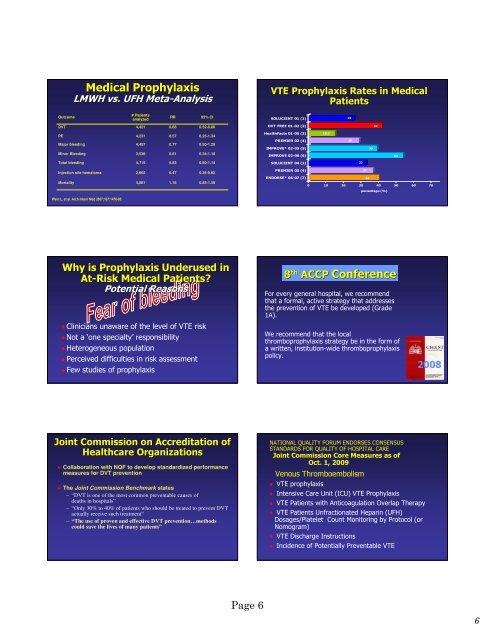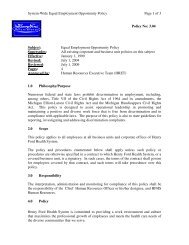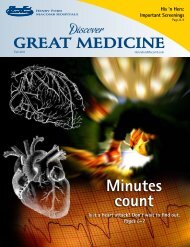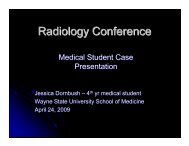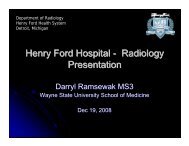Venous Thromboembolism (DVT and PE) Overview
Venous Thromboembolism (DVT and PE) Overview
Venous Thromboembolism (DVT and PE) Overview
You also want an ePaper? Increase the reach of your titles
YUMPU automatically turns print PDFs into web optimized ePapers that Google loves.
Medical Prophylaxis<br />
LMWH vs. UFH Meta-Analysis<br />
VTE Prophylaxis Rates in Medical<br />
Patients<br />
Outcome<br />
# Patients<br />
analyzed<br />
RR<br />
95% CI<br />
SOLUCIENT 01 (1)<br />
26<br />
<strong>DVT</strong><br />
4,421<br />
0.68<br />
0.52-0.88<br />
<strong>DVT</strong> FREE 01-02 (2)<br />
42<br />
<strong>PE</strong><br />
Major bleeding<br />
Minor Bleeding<br />
4,231<br />
4,497<br />
3,538<br />
0.57<br />
0.77<br />
0.61<br />
0.25-1.34<br />
0.50-1.20<br />
0.34-1.10<br />
HealthFacts 01-05 (3)<br />
PREMIER 02 (4)<br />
IMPROVE* 02-03 (5)<br />
IMPROVE 02-06 (6)<br />
15.3<br />
29<br />
39<br />
54<br />
Total bleeding<br />
4,715<br />
0.83<br />
0.60-1.14<br />
SOLUCIENT 04 (1)<br />
33<br />
Injection site hematoma<br />
Mortality<br />
2,002<br />
4,881<br />
0.47<br />
1.16<br />
0.36-0.62<br />
0.85-1.59<br />
PREMIER 05 (4)<br />
37<br />
ENDORSE* 06-07 (7)<br />
40<br />
0 10 20 30 40 50 60 70<br />
percentage (%)<br />
Wein L, et al. Arch Intern Med 2007;167:1476-86.<br />
Why is Prophylaxis Underused in<br />
At-Risk Medical Patients?<br />
Potential Reasons<br />
Clinicians unaware of the level of VTE risk<br />
Not a ‘one specialty’ responsibility<br />
Heterogeneous population<br />
Perceived difficulties in risk assessment<br />
Few studies of prophylaxis<br />
8 th ACCP Conference<br />
For every general hospital, we recommend<br />
that a formal, active strategy that addresses<br />
the prevention of VTE be developed (Grade<br />
1A).<br />
We recommend that the local<br />
thromboprophylaxis strategy be in the form of<br />
a written, institution-wide thromboprophylaxis<br />
policy.<br />
Gee WH, et al. CHEST 2001;119:132S-175S.<br />
2008<br />
Joint Commission on Accreditation of<br />
Healthcare Organizations<br />
Collaboration with NQF to develop st<strong>and</strong>ardized performance<br />
measures for <strong>DVT</strong> prevention<br />
The Joint Commission Benchmark states<br />
– “<strong>DVT</strong> is one of the most common preventable causes of<br />
deaths in hospitals”<br />
– “Only 30% to 40% of patients who should be treated to prevent <strong>DVT</strong><br />
actually receive such treatment”<br />
– “The use of proven <strong>and</strong> effective <strong>DVT</strong> prevention…methods<br />
could save the lives of many patients”<br />
NATIONAL QUALITY FORUM ENDORSES CONSENSUS<br />
STANDARDS FOR QUALITY OF HOSPITAL CARE<br />
Joint Commission Core Measures as of<br />
Oct. 1, 2009<br />
<strong>Venous</strong> <strong>Thromboembolism</strong><br />
VTE prophylaxis<br />
Intensive Care Unit (ICU) VTE Prophylaxis<br />
VTE Patients with Anticoagulation Overlap Therapy<br />
VTE Patients Unfractionated Heparin (UFH)<br />
Dosages/Platelet Count Monitoring by Protocol (or<br />
Nomogram)<br />
VTE Discharge Instructions<br />
Incidence of Potentially Preventable VTE<br />
Page 6<br />
6


